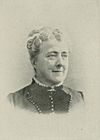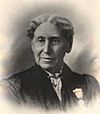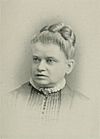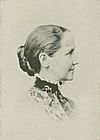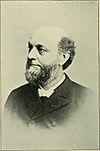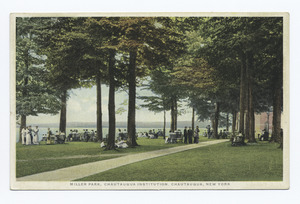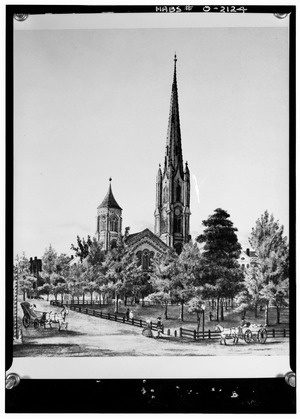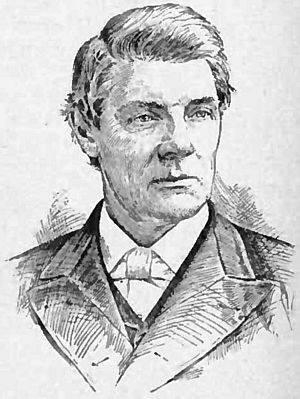First Woman's National Temperance Convention facts for kids
The First Woman's National Temperance Convention was a very important meeting that helped start the Woman's Christian Temperance Union (WCTU). This group worked to encourage people to live healthy lives and avoid alcohol.
In November 1874, this special convention was held in Cleveland, Ohio. Jennie Fowler Willing led the meeting. Her hard work was a big reason why this national organization began. At this convention, they created a set of rules and a plan to reach every city and town in the United States. They sent messages to women and girls across America. They also wrote a letter to other countries and a request to the U.S. Congress.
The women also planned to start a national newspaper. It would be written and published by women. Each member of the Union would give a small amount of money, just one cent per week, to help pay for it. A special group was also formed to work on encouraging good habits among children.
The main leaders chosen for the new organization were Annie Turner Wittenmyer as President, Frances Willard as Corresponding Secretary, Mary Coffin Johnson as Recording Secretary, and Mary Bigelow Ingham as Treasurer. Each state that sent representatives also had a vice-president. The strong spirit of this meeting was clear in the final decisions they made.
Contents
How the Idea Started
In the spring of 1874, women in states like Ohio, Indiana, and Pennsylvania had already started a movement. They were working hard to encourage people to avoid alcohol. These women decided to hold a meeting to talk about their efforts. This led to the creation of State Temperance Leagues. Soon, they changed the name to "Union." This new name showed that the group welcomed everyone, no matter their religious background.
The idea for a national convention came about in August 1874. It happened during a large gathering called the "Chautauqua Lake Sunday School Assembly." This event took place at Miller Park, near Chautauqua Lake, New York. Thousands of people attended, including the wives of Methodist church leaders.
During a prayer meeting, Martha McClellan Brown had the idea for a national temperance convention. She shared her idea with the other women. Important women, with encouragement from men, decided to move forward. They wanted to bring this idea to women all over the United States. Jennie Fowler Willing and Emily Huntington Miller were chosen to send out invitations. Martha McClellan Brown, known as the "prime mover," worked with Mary Bigelow Ingham, Jennie Fowler Willing, and Emily Huntington Miller. Women who supported the temperance cause from all over the U.S. loved the idea. Soon, meetings were held in different states, and representatives were chosen to attend the national convention.
Who Attended the Meeting?
The convention was held in the main hall of Cleveland's Presbyterian church. Many different kinds of people attended this meeting. They came from various places and had different backgrounds. For example, Judith Ellen Foster, a lawyer from Iowa, helped make sure everything followed the law. Dr. Harriet Schneider French, a doctor from Philadelphia, talked about how alcohol affects medicine.
There were also newspaper editors, many teachers, and two college professors. Some Quaker ministers, known for their simple clothing, were also there. In addition, three licensed Methodist preachers, businesswomen, and older, wise women attended. It was a truly diverse group of women working together for a common goal.
Organizing the Convention
Leaders for the Day
Jennie Fowler Willing started the convention. The attendees sat in groups based on their states and areas. This helped keep things organized. They chose a temporary committee to help run the meeting. This committee had one person from each state. They then announced the leaders for the convention:
- President: Jennie Fowler Willing
- Vice-Presidents: Abby Fisher Leavitt, Zerelda G. Wallace, Mrs. J. Backus, Mrs. Matchett, Elizabeth Eunice Marcy, Susan A. Gifford, Susan J. Swift Steele, Mary Torrans Lathrap, Helen E. Brown, Emma A. Wheeler, Elizabeth Chamberlain Gibson, Lizzie Boyd
- Secretaries: Auretta Hoyt, Mary Towne Burt
- Treasurer: Mary Bigelow Ingham
These women were officially chosen. There was a brief discussion about people who didn't bring their official papers. But Annie Turner Wittenmyer offered a solution. She said that each state could add more representatives if they needed to. This helped everyone feel included.
Working Groups
After the temporary leaders were chosen, the convention got to work. They formed many different committees to handle various tasks. These committees showed the wide range of topics the women wanted to address. Some committees focused on checking who was attending, while others planned what to discuss. There were groups for writing letters to other countries and to the U.S. Congress. Other committees worked on creating the group's rules and managing its money. There were also committees dedicated to reaching out to young women and children.
Important Decisions Made
The convention adopted several important resolutions. These were like a "statement of belief" for the group. They showed what the women stood for and what they wanted to achieve.
Here are some of the key decisions they made:
- They strongly disagreed with the idea of choosing people for public office who did not set a good example.
- They decided to ask the House of Representatives to support a bill. This bill would create a group to study the effects of alcohol in the country.
- They politely asked the President, members of Congress, governors, and other public figures to show their support. They hoped these leaders and their families would remove alcohol from their official dinners and private homes. This would set a good example.
- They planned to work with large companies. They wanted to encourage employees to completely avoid alcohol. They also asked companies to consider paying their workers on Monday instead of Saturday evening. This was thought to help people avoid spending their wages on alcohol over the weekend.
- They respectfully asked doctors to be very careful when giving alcohol as medicine.
- They recommended that women encourage others to read books and articles about temperance. They believed that sharing information was important.
- They invited all other groups working for temperance to join them. They wanted everyone to work together.
- They warmly invited all good women, no matter their background, to join their fight for what is right.
- They believed that religious leaders and the news media were their strongest helpers. They promised to pray and work to increase interest in their cause.
- They planned to pray and work for a spiritual revival across the country. They believed that strong faith would help people care more about the temperance cause.
- They knew their cause would face strong challenges. But they decided to meet arguments with arguments, misunderstandings with patience, and criticism with kindness. They would face all difficulties with prayer and trust.
Forming the WCTU
The convention officially adopted a set of rules, called a constitution. It stated that the new group would be known as the "Woman's National Christian Temperance Union." After this, they held an election to choose the first official leaders of the WCTU.
The newly elected officers were:
- President: Annie Turner Wittenmyer
- Vice-Presidents: Mary A. Gaines, Harriet Maria Haven, Susan A. Gifford, Mercy Ann Mann Kenyon, Fanny DuBois Chase, Eliza Thompson, Mrs. Rev. S. Reed, Elizabeth Eunice Smith Marcy, Susan J. Swift Steele, Zerelda G. Wallace, Mary Jane Aldrich, Caroline Batchelder Thompson
- Corresponding Secretary: Frances Willard
- Recording Secretary: Mary Coffin Johnson
- Treasurer: Mary Bigelow Ingham
Public Gatherings
During the convention, four large public meetings were held. Dr. John Morgan Walden led the first one. This was a special honor because he was the only man allowed to speak during the entire convention. Abby Fisher Leavitt led the second meeting. Mrs. Dr. Donaldson from Toledo, Ohio led the third. Auretta Hoyt led the fourth. Many people came to these meetings. They sang special songs, called Crusade hymns, along with music provided by talented singers from Cleveland.
Images for kids


